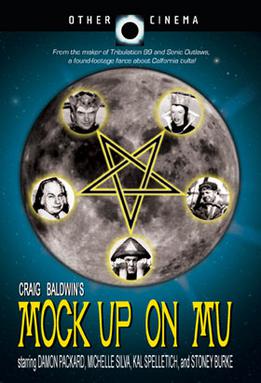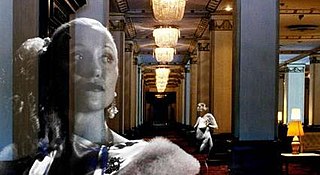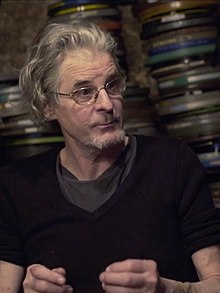David Holzman's Diary is a 1967 American mockumentary, or work of metacinema, directed by James McBride and starring L. M. Kit Carson. A feature-length film made on a tiny budget over several days, it is a work of experimental fiction presented as an autobiographical documentary. "A self-portrait by a fictional character in a real place—New York's Upper West Side," the film comments on the title character's personality and life as well as on documentary filmmaking and the medium of cinema more generally. In 1991, David Holzman's Diary was included in the annual selection of 25 motion pictures added to the National Film Registry of the Library of Congress, being deemed "culturally, historically, or aesthetically significant" and recommended for preservation.

A Movie is a 1958 experimental collage film by American artist Bruce Conner. It combines pieces of found footage taken from various sources such as newsreels, soft-core pornography, and B movies, all set to a score featuring Ottorino Respighi's Pines of Rome.
A mockumentary is a type of film or television show depicting fictional events, but presented as a documentary which in itself is a subset of a faux-documentary style of film-making.

Forgotten Silver is a 1995 New Zealand mockumentary film that purports to tell the story of a pioneering New Zealand filmmaker. It was written and directed by Peter Jackson and Costa Botes, both of whom appear in the film in their roles as makers of the documentary.

Richard Stanley is a South African filmmaker, known for his work in the horror genre. He began his career making short films and music videos, and subsequently directed the feature films Hardware (1990) and Dust Devil (1992), both of which are considered cult classics. He was the original director of The Island of Dr. Moreau (1996), but was fired early into principal photography due to creative differences, an episode recounted in the 2014 documentary Lost Soul: The Doomed Journey of Richard Stanley's Island of Dr. Moreau. In 2019, he returned to feature films after more than 20 years, directing the H. P. Lovecraft adaptation Color Out of Space.
Tomás Gutiérrez Alea was a Cuban film director and screenwriter. Gutiérrez Alea wrote and directed more than twenty features, documentaries, and short films, which are known for his sharp insight into post-Revolutionary Cuba, and possess a delicate balance between dedication to the revolution and criticism of the social, economic, and political conditions of the country.

The Gleaners and I is a 2000 French documentary film by Agnès Varda that features various kinds of gleaning. It screened out of competition at the 2000 Cannes Film Festival, and later went on to win awards around the world. In a 2014 Sight & Sound poll, film critics voted The Gleaners and I the eighth best documentary film of all time. In 2016, the film appeared at No. 99 on BBC's list of the 100 greatest films of the 21st century. The film was included for the first time in 2022 on the critics' poll of Sight and Sound's list of the greatest films of all time, at number 67.
Queen of Blood is a 1966 science fiction horror film produced by George Edwards and Samuel Z. Arkoff, directed by Curtis Harrington, that stars John Saxon, Basil Rathbone, Dennis Hopper, and Judi Meredith. The film is based on the screenplay for the earlier Soviet feature film Mechte Navstrechu. Director Harrington also reused special effects footage from that film, as well as footage from the Soviet science fiction film Nebo Zovyot.

Ken Jacobs is an American experimental filmmaker. His style often involves the use of found footage which he edits and manipulates. He has also directed films using his own footage.

Bill Daniel is an American experimental documentary film artist, photographer, film editor, and cinematographer. He is also an installation artist, curator, and former zine publisher. His full-length film, Who is Bozo Texino? about the tradition of hobo and railworker boxcar graffiti was completed in 2005 and has screened extensively throughout the United States and Europe. Daniel has collaborated with several artists from the Bay Area Mission School art movement, notably Margaret Kilgallen and has worked on multiple projects with underground director Craig Baldwin. Film/video artist Rankin Renwick of the Oregon Department of Kick Ass has been a frequent touring partner, collaborator and co-curator.

Plan 9 from Outer Space is a 1957 American independent science fiction-horror film produced, written, directed, and edited by Ed Wood. The film was shot in black-and-white in November 1956 and had a preview screening on March 15, 1957, at the Carlton Theatre in Los Angeles under the title Grave Robbers from Outer Space. Retitled Plan 9 from Outer Space, it went into general release in July 1958 in Virginia, Texas and several other Southern states, before being sold to television in 1961.

No Lies is a 1973 American short drama film made by Mitchell Block while he was a student at New York University.

The myth of the Seven Cities of Gold, also known as the Seven Cities of Cíbola, was popular in the 16th century and later featured in several works of popular culture. According to legend, the seven cities of gold referred to Aztec mythology revolving around the Pueblos of the Spanish Nuevo México, modern New Mexico and Southwestern United States.

Mock Up on Mu is a 2008 science fiction collage film directed by American experimental filmmaker Craig Baldwin. The film is a fictionalized continuation of the stories of L. Ron Hubbard, Jack Parsons, and Marjorie Cameron. Baldwin assembled it mostly from found footage but began introducing more original live-action footage than in earlier projects.
Collage film is a style of film created by juxtaposing found footage from disparate sources. The term has also been applied to the physical collaging of materials onto film stock.

The Decay of Fiction is a 2002 American 35mm part color and part black-and-white experimental film noir project directed by independent filmmaker and artist Pat O'Neill. The film, initially conceived as a documentary, was produced by O'Neill and Rebecca Hartzell for Lookout Mountain Films. Filming took place in Los Angeles.
Adam Benzine is a British filmmaker and journalist. He received critical appraisal and widespread acclaim for his HBO documentary Claude Lanzmann: Spectres of the Shoah, which examined the life and work of French director Claude Lanzmann. The film earned Benzine an Oscar nomination in the Best Documentary category at the 88th Academy Awards, in addition to nominations from the Grierson Awards, the Canadian Screen Awards, the IDA Documentary Awards, the Banff Rockie Awards and the Cinema Eye Honors.

Hyperfutura is a 2012 science fiction film from American filmmaker James O'Brien, starring Eric Kopatz, Karen Corona, Gregory Kiem, Scott Donovan, Celine Brigitte, Alysse Cobb, Lionel Heredia, Gary Kohn, Edward Romero and William Moore. It draws elements from the mashup video movement, Ed Wood, time travel and transhumanism, and pays homage to such counterculture works as The Church of the SubGenius and the fictional experimental filmmaker James Orin Incandenza from the David Foster Wallace novel Infinite Jest. Utilizing both stock footage and a live action narrative, it takes the viewer on a psychedelic voyage into the subconscious of a hybrid robot human sent back in time.
Tribulation 99: Alien Anomalies Under America is a 1991 science fiction collage film directed by Craig Baldwin. The film presents a chronicle of U.S. involvement in Latin America through a pseudo-documentary about an alien invasion.

Spectres of the Spectrum is a 1999 science fiction collage film by American filmmaker Craig Baldwin. The story follows a father and daughter living in post-apocalyptic wasteland as they fight against corporate control of the electromagnetic spectrum. The film mixes found footage with live-action scenes.














